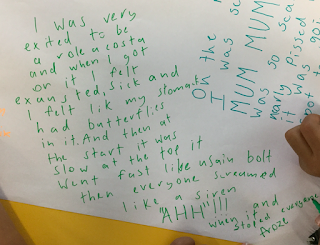Last week I attended the Manaiakalani Lead Teacher's PLG. Dr. Aaron Wilson is one of the researchers at the University of Auckland and he was sharing his views about the importance of multimodal reading. It is different to reading a story in a journal over the week. Multimodal texts show the interrelationship between reading and writing and develop deeper understanding of the texts by making meaning of different modes of communication.
We talked about
- Why it is important to talk about the text and how it benefits children's learning?
- What are some of the key indicators of quality talk about texts?
We shared our ideas on a padlet. Click on the link below to view the ideas.
Aaron emphasised and we all agreed that IRE ( Initiation, response and evaluation) way of teaching can be useful if it helps the teacher to check understanding of students. But it has it's limitations. It is one sided as it is teacher centred. Students do not get involved into deeper understanding of the topic as they do not get a chance to explore about the topic.
Texts should be talked about and students should be given opportunities to share their opinions about the ideas in the text. This would enhance deeper understanding of the text. Ideas in the text develop into rich discussions between the teacher and the students and within groups as everyone questions, agrees and disagrees. Most discussions are supported by reasons and so everyone contributes to the learning.
Teachers need to very careful about the level of the students and multimodal reading can become very disengaging if texts are not chosen strategically. Click the link below to see what Aaron had to say about what makes rich talks harder and easier.
What factors make rich talk about text in classrooms harder and easier
Aaron has been working with teachers at Tamaki College and showed us how there was a change between the teacher and student utterances as teachers shifted form IRE to more meaningful and authentic discussions.
Observations in the beginning of the year
Observations - mid year
Observations towards the End of the year
Aaron discussed that it could be valuable to re- negotiate the norms in the class about talk. I personally believe that it is very important to keep visiting the norms in the class as they develop a culture where everyone feels supported and comfortable to participate in discussions.
Our class treaty is all about class norms and has worked well for me and my students. It is not just a poster that hangs on the walls. It is very much a living document that is referred by students and teachers regularly so that our class remains a healthy place to discuss, ask, inquire, justify, agreeing and disagreeing. This is what our class treaty looks like-
I have not changed this treaty for the last two years because it works for me. What changed is just the koru patterns.
To involve students in discussions we also practice talk moves. Both me and my co- teacher Ashley use talk moves in all areas of the curriculum.
In the end Aaron left us with some question to ponder over?
- Are we on board with a shared focus on deep and wide learning using text sets and talk about text approaches?
- How many times should we engage students in multimodal literacy?
In my opinion, this is a great way to develop critical thinking amongst students. I have tried this in my class and the results were very satisfying for me as well as for the students. They felt like they had a voice and that their ideas and opinions were valued.
The topic of my multimodal literacy was Theme parks. Please view the presentation below to check what year 3 and 4 students did for their reading last week.









